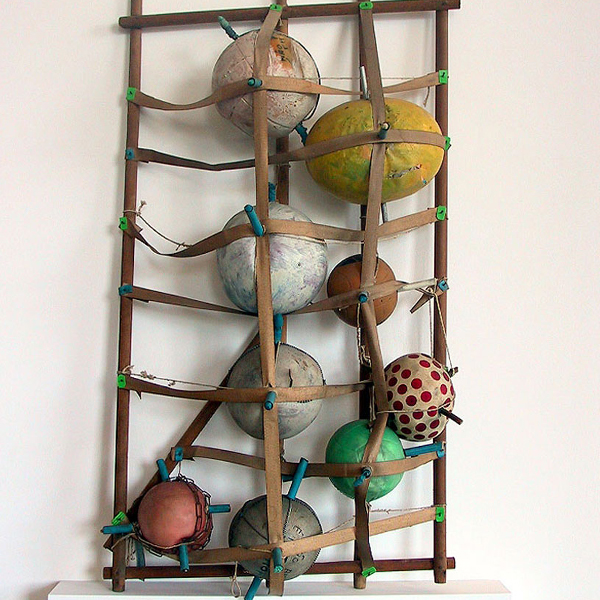
Arthur Bispo di Rosario
Born in 1911, in the city of Japaratuba, Sergipe. It is known that it was carabineer of the navy and boxer, arriving to Latin American champion of the light weigh category. He was stopped several times by insubordination and was separated of the War Navy in 1933.
He worked in Rio de Janeiro as: employee of electricity company, domestic employee, security guard, hotel janitor; almost all the time exchanging his salary by housing. In 1938 he was confined in the psychiatric Hospital Pedro II, in Rio de Janeiro after raving during 2 days in the street. He was later confined in the Hospital Praia Bermelha. In 1939 presented mystical deliriums, claiming he had seen Jesus Christ in company of blue angels and said he was Saint Joseph. Transferred to the Colìnia Juliano Moreira he began to develop his creative process using simple materials. His expression needs were so intensive that he unstitched his uniform to use the threads in his embroideries. Defended with obstinacy his projects, keeping them away carefully. He built a miniatures universe. The work "inspirational by the angels and by the virgin Mar°a would be presented God in the day of the Final Judgement. He never considered himself an artist. The aesthetic trip of Arthur Bispo Do Rosario was a "mission" dictated by heavenly beings. When someone asked him by his origins he diverted the matter: he was sent from the sky, a Christ. And said "one day I simply appeared in this world".
Frederico Moraes, an enthusiastic defensor of his work organized the first exhibition at the Visual Arts School. The show had a great public and critique response and it could only be accomplished after his death. This exhibition arrived to Europe in 1995 participating of the XLVI Biennial of Venice where also awoke surprise and admiration. In certain periods of 1 or 2 weeks Bispo fasted to be purified and be become transparent to the command of our Lady, according to his words. He died to 78 years of a miocard infart and artereoesclerosis in the colony. The Museum Nise Da Silveira hosts a group of work of Arthur Bispo do Rosario in its permanent collection.
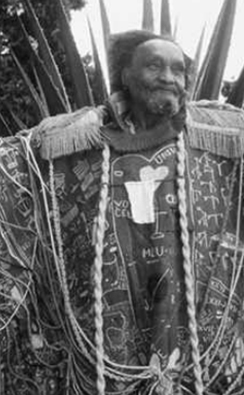
Raphael Domingues
Raphael, the oldest of four brothers, was born in July of 1913 in the state of San Pablo. His father was sculptor and worked making funeral monuments. His mother was brasilean of Italian ancestry. She describes him as a shy child, sensitive and withdrawn. When his father abandons the family, Raphael, in order to help with the sustenance of his brothers, worked as assistant in the manufacture of cages for birds. At 13 he entered the Liceu Liter†rio Portuguàs where he studied academic drawing. Worked as drawer in private agencies and was given a prize in an art contest of the Standart Oil Company.
The first symptoms of their/its/your/his disease was expressed when had 15 years. His case was serious. At 19 years old he was confined in the Hosital do Praia Vermelha. Transferred to the Psychiatric Center Pedro II, draws in the walls of the nursing. For that motive is sent to the atelier of the Museum of Images of the Unconscious. The presence of the artist Almir Mavignier is fundamental in the history of Raphael. Meant for him affective support and constant stimulus. Always next to him during his activities, but intending any influence. One day, contradicting the rule of not-intervention in the production of the interns, an official entered by chance and seeing the drawings of Raphael said to him: "Raphael, paint a face". Raphael immediately drew a face. The official said "Now paints a donkey". Raphael painted a donkey. That unusual act marked the beginning of a new phase in the drawings of Raphael. From then on, without stages of transition neither grisly jumps, emerge magic outlines that go to configure drawings of the best quality within his production. When he finished his drawings, Raphael continued covering them with his usual crossed lines, monitors had to take the paper and to give to him a new one. He drew quickly, with lines that reproduce on the paper gestures that he made. The pleasure of drawing in an environment in which he was treated as a loved person awoke unsuspectedly in Raphael creative force manifestations. His drawings reached a high quality, recognized by art critics such as Leon Degand, SÇrgio Millet, Antìnio Bento, Flavio de Aquino and others.
The qualities of his drawings awoke fascination and respect. Murillo Mendes, Abraham Palatnik and M†rio Pedrosa, among others, admired him and they were portrayed in some of his works.
Participated of various individual and collective expositions in Brazil and abroad. Drew in the atelier of painting until July of 1979, dying in November of the same year.
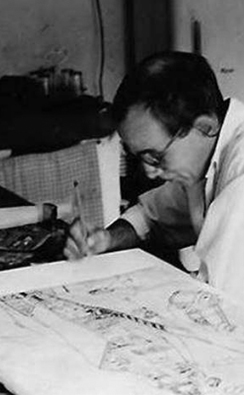
Carlos Pertuis
He was born in Rio de Janeiro on december 4th, 1910. His grandfathers were french, as well as his father that arrived to Brazil as a child. He was the only boy in the family and had three sisters. Very attached to his mother, of fragile physical structure and psicologically immature. Had a religious and sensitive nature. In spite of the fact that his education was basic, was an enthusiastic reader. With the death of his father he droped his studies and began to work in a shoes factory.
One morning, the sun beams reflected on a small mirror of his room produced an extraordinary sheen that glared it and made emerge before his eyes a cosmic vision "The God planetarium", according to his words.
He screamed, called his family, and wanted them to see the wonders he had seen. That same day he was confined in the old Hospital do Praia Vermelha, in September of 1939, at 29 years old.
In 1946 he began to frequent the atelier of the occupational therapeutic section, brought by Almir Mavignier who knew he kept his drawings away in shoe cases in the nursing. Carlos loved the Museum, the atelier of painting, the binding office. He spent the entire day there and he felt it was his home. In the museum he repaired the loose ribbons of the wood floor and checked at the en of the day that all the windows were closed. These facts were surprising and they were commented in the hospital, since the verbal expressions of Carlos were practically unintelligible. The great quantity of neologisms that he used made his words difficult of understanding. Carlos descended to the field of arquet°pic images, the gods, the demons. With great intensity produced about 21,500 drawings, paintings, models, xylographies, before his death 21 of March of 1977. He participated of various individual and collective exhibitions, in Brazil and abroad. His life and work were registered in a film by Leon Hirszman. According to Mario Pedrosa, this art "is of essence, clear, and the desire, first of all, of being intelligible". The attachment to external perceptions is rarified and distant. He continues producing from his imagination, worlds and landscapes of greater transcendency every time, distant of the blows of the world.
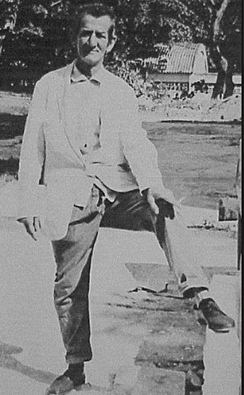
Fernando Diniz
Was born in Aratu, Bahia, in 1918. Mulatto, poor, he never knew his father. At 4 he traveled to Rio de Janeiro with his mother that was an excellent costurer. He resided in old subdivided houses and accompanied his mother when she worked in the rich family houses. The dream of Fernando was to be engineer. Intelligent, always the first of his class and informed about the scientific news. In July of 1944 was carried to the Manicìmio Judici†rio. In 1949 is moved to the Psychiatric Center Pedro II where he started to frequent the atelier of the Museum of Images of the Unconscious.
Fernando was an eternal apprentice. His passion by books made him constantly updated on new discoveries and scientific events. He was interested in astronomy, chemistry, nuclear physics and data processing, revealing himself as a tireless researcher. His production in the Museum is estimated in about 30,000 works. Fernando died on March 5th, 1999 of a cardiopat°a and cancer.
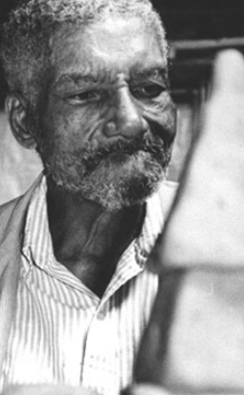
Arthur Amore
Born in Aratu, Bahia, Brazil in 1918.
Had a short passage by the Museum of Images of the Unconscious towards the end of the '40, little is known about him.
He arrived to the workshop with the desire of painting, but declaring that he did not know how to draw. They proposed him to seek for a motive or topic of his interest. He discovered a domino case and copied all the pieces, then began to simplify them, abandoning the points, covering the black and white faces, breaking the angles, finding curves and creating strong optical contrast structures. He considered black and white as sufficient colors for his work. He titled his compositions with titles of musical pieces by Beethoven, Schubert and Chopin. He refused to show the works to his family fearing to be considered hazardous. He wanted to return to his home. His compositions in white and black were accomplished approximately between 1949 and 1951. He produced five oils, four drawings and projects on paper. He left the hospital later.
At that time, groups of artists influenced by swiss geometric artists called "Concrete" discussed in the Rio de Janeiro - S_o Paulo cities on who would be the protagonists of the concrete movement in Brazil.
Amora's projects reveal a consequent geometrism free of foreign influences.